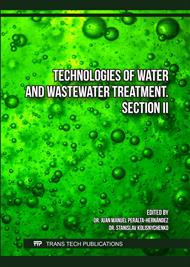[1]
Zh.A. Sverguzova, D.A. Elnikov, S.V. Sverguzova, About the possibility of using the waste of the sugar industry for wastewater treatment , Bulletin of BSTU named after V.G. Shukhov. 3 (2011) 128-133.
Google Scholar
[2]
Zh. A. Sapronova, S.V. Svergusova, E.V. Fomina, Nanocomposite carbon-bearing sorption material, Advances in Engineering Research. 133 (2017) 728-733.
Google Scholar
[3]
Zh. A. Sapronova, D.V. Sapronov, Yu.L. Starostina, Combined Extender Pigments Based on Industrial Wastes, Solid State Phenomena. 265 (2017) 450-455.
DOI: 10.4028/www.scientific.net/ssp.265.450
Google Scholar
[4]
Zh.A. Sapronova, S.V. Sverguzova, A.V. Svyatchenko, About a possibility of usage of sugar beet industrial carbonate containing byproducts in dry construction mixtures and oil paints manufacturing solid state phenomena. 284 (2018) 899-904.
DOI: 10.4028/www.scientific.net/ssp.284.899
Google Scholar
[5]
Zh. Sapronova, S. Sverguzova, E. Fomina, E. Fokina, Carbonate-containing precipitate of sugar production from sugar beet as filler for polymer concrete, IOP Conf. Ser.: Mater. Sci. Eng. 365 (2018) 032042.
DOI: 10.1088/1757-899x/365/3/032042
Google Scholar
[6]
I.V. Starostina, S.V. Sverguzova, I.V. Ovcharova, P.V. Besedin, E.A. Pendurin, E.M. Kuzina, Recycling of microbiological industry waste with the obtaining of foaming agents for building industry. 10 (2015) 42701-42706.
Google Scholar
[7]
S.V. Sverguzova, Zh.A. Sapronova, I.V. Starostina, Disposal of synthetic surfactants-containing wastewater treatment sludge in the ceramic brick production, Procedia engineering. 12 (2016) 1610-1616.
DOI: 10.1016/j.proeng.2016.07.138
Google Scholar
[8]
S.V. Sverguzov, J.A. Sapronova, A.V. Svyatchenko, T. Otiti, Adsorption of spindle oil by native and thermal modified chestnut tree waste, Construction materials and products.1 (1) (2018) 4-11.
DOI: 10.34031/2618-7183-2018-1-1-4-11
Google Scholar
[9]
Zh. Sapronova, S. Sverguzova, K. Sulim, A. Svyatchenko, E. Chebotaeva, Sewage treatment in megacities by modified chestnut tree waste, IOP Conf. Ser.: Mater. Sci. Eng. 365 (2018) 022058.
DOI: 10.1088/1757-899x/365/2/022058
Google Scholar
[10]
Z. Zakaria, M. Z. Sulieman, R. Talib, Turning natural fiber reinforced cement composite as innovative alternative sustainable, Construction material: a review paper noor, International journal of advanced engineering, Management and Science (IJAEMS). 1 (8) (2015) 24-31.
Google Scholar
[11]
A. Marzuki, S. Rahim, M. Hamidah, R. Ahmad, Effects of wood: cement ratio on mechanical and physical properties of three-layered cement-bonded particleboards from leucaena leucocephala, Journal of tropical forest science 23 (1) (2011) 67–72.
Google Scholar
[12]
R.M. Ronquim, F.S. Ferro, F. H. Icimoto, C. I. Campos, M. da S. Bertolini, A. L. Christoforo, F.A. Rocco Lahr Physical, Mechanical properties of wood-cement composite with Llignocellulosic grading waste variation, International journal of composite materials, 4 (2) (2014) 69-72.
DOI: 10.5923/j.cmaterials.20140402.05
Google Scholar
[13]
G. C. H. Doudart de la Grée, , Q. L. Yu, H. J. H. Brouwers, Wood-wool cement board : potential and challenges, International conference non-traditional cement and concrete. June 16-19 (2014) 279-282.
Google Scholar
[14]
C. H. S. del Menezzi 1, V. G. de Castro, M. R. de Souza, Production and properties of a medium density wood-cement boards produced with oriented strands and silica fume, Maderas, Ciencia y tecnología. 9 (2) (2007) 105-115.
Google Scholar
[15]
GOST 19222-84. Wood cement composites and products from it, Standardinform, Moscow, (1985).
Google Scholar
[16]
I.E. Kazimagomedov, A.V. Lobanov, F.I. Kazimagomedov, Simulation of components of wood cement composites based on flax fires, Processing systems information. 3 (140) (2016) 209-212.
Google Scholar
[17]
D. Małaszkiewicz, M. Sztukowska, Utilization of wastes from medium density fiberboards production as an aggregate for lightweight cement composite, Matec web of conferences. 174 (2018) 10 (02005).
DOI: 10.1051/matecconf/201817402005
Google Scholar
[18]
S.U. Ibearugbulam, O.M. Onukwugha, E.R. Anyaogu, L. Adah, E.I Structural, Characteristics of sawdust-sand-cement composite okoroafor, International journal of advancements in research and technology. 6 (1) (2017) 173-180.
Google Scholar
[19]
R. Setiadji, A. A. Husin, Utilization of eucalyptus oil refineries waste for cement particle board, International journal of sustainable construction engineering and technology. 3(2) (2012) 10.
Google Scholar
[20]
Z. Dong, Y. Yu, P.Song, L. Ma, F. Lu, Effects of two types of waste wood species on the hydration characteristic of portland cement, journal of advanced concrete technology. 14 (2016) 13-20.
DOI: 10.3151/jact.14.13
Google Scholar
[21]
R.A. Olaoye, J.R. Oluremi, S.O. Ajamu, The use of fibre waste as complement in concrete for a sustainable environment innovative systems design and engineering, International conference on engineering and technology research. 4(9) (2013) 91-97.
Google Scholar
[22]
V.V. Bozylev, A.N. Yagubkin, On the issue of selection of the composition and dosage of wood cement composites modifier additives, Bulletin of Polotsk State University 6 (2010) 84-89.
Google Scholar
[23]
B. Na, Z. Wang, H. Wang, X. Lu, Wood-cement compatibility review Nanjing forestry university, College of materials science and engineering nanjing, China wood research 59(5) (2014) 813-826.
Google Scholar
[24]
M. Paterska, H. Bandurska, J. Wysłouch, M. Molinska-Glura, K. Molinski, Chemical composition of horse-chestnut (Aesculus) leaves and their susceptibility to chestnut leaf miner Cameraria ohridella Deschka and Dimic, Acta physiologiae plantarum. 3 (2017) 105.
DOI: 10.1007/s11738-017-2404-y
Google Scholar
[25]
GOST 10178-85. Portland cement and portland blastfurnace slag cement. Specification, Moscow, (1998).
DOI: 10.3403/00159694
Google Scholar
[26]
GOST 5802-86. Mortars. Test methods. Мoscow, Standardinform, (2010).
Google Scholar



